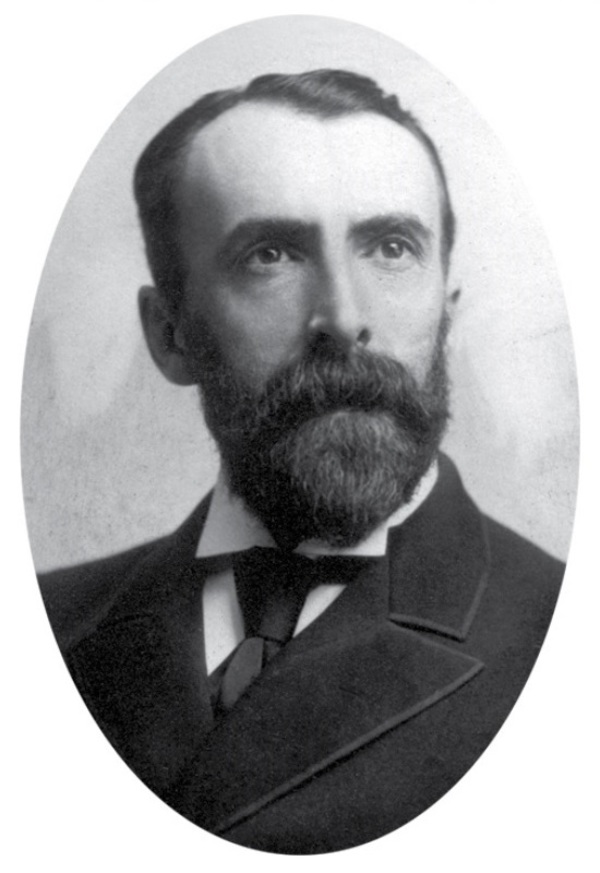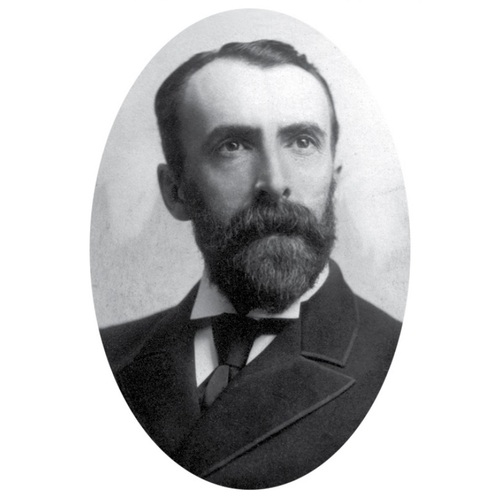
Source: Courtesy of Wikimedia Commons
ROUILLARD, EUGÈNE (baptized Nicolas-Olivier-Eugène), notary, journalist, office holder, author, and geographer; b. 4 June 1851 at Quebec, son of Nicolas Rouillard, a merchant, and Éliza Legris, dit Lépine; m. there 10 Jan. 1881 Orpha Myrand, and they had three sons and four daughters; d. there 16 Oct. 1926.
Eugène Rouillard, who was the son of a merchant in Quebec’s Lower Town, pursued his classical studies at the Petit Séminaire de Québec from 1860 to 1872. He enrolled in the Université Laval at Quebec in 1872 and graduated three years later with an llb. On 17 May 1876 he was licensed to practise as a notary, and he would carry on this profession at Quebec until 1884, working as a journalist at the same time. He founded Le Nouvelliste, a Conservative daily, on 27 Nov. 1876 and he was its editor-in-chief and co-owner until 23 Oct. 1886, when the paper ceased publication because of a dispute between Rouillard and his business partner, J. G. Gingras, about its political orientation. Having worked at Le Canadien from the end of 1886 until the end of 1888, he became editor-in-chief of L’Événement, a position he retained from 1889 until the end of 1891. On 13 Jan. 1892 the Conservative party launched the daily Le Matin, through the agency of Louis-Philippe Pelletier, in anticipation of the coming provincial general election. Rouillard was its sub-editor until it ceased publication on 19 September. He distinguished himself as a journalist by the great variety of subjects he addressed (politics, libraries, the French language, place names) and by his support for the Conservative party. He was the author of nearly 600 newspaper articles.
Rouillard also worked in the civil service. He was a federal government census commissioner in 1881 and 1891 and a civil service examiner from 1882 to 1893. On 14 Oct. 1892 he had been hired by the Quebec provincial government as crown clerk in chancery. Edmund James Flynn, the commissioner of crown lands, appointed him superintendent of land sales for the eastern section of the province on 3 July 1893. He would hold this office until 1905, when he would become secretary of land sales. On his visits to sparsely inhabited and uninhabited regions, he took an interest in a wide range of subjects related to geography, in particular the characteristics of places, natural resources, rivers and means of communication, the potential for colonization, and place names.
In the course of his duties, Rouillard brought out La colonisation dans les comtés de Témiscouata, Rimouski, Matane, Bonaventure, Gaspé in 1899, La colonisation dans les comtés de Dorchester, Bellechasse, Montmagny, L’Islet, Kamouraska in 1901, and La Côte nord du Saint-Laurent et le Labrador canadien . . . in 1908. Published at Quebec, these monographs dealt with the parishes, their people, and their resources (the dairy industry, forestry, roads, rivers). Other works by Rouillard highlighted the province’s flourishing wildlife and its hydroelectric potential. As a civil servant, he was involved in lawsuits dealing with territorial issues, zoning (before the term existed), and the use that should or should not be made of land and its management. His work schedule from 3 May 1895 to 27 May 1899 shows the diversity of his duties, the kind of decisions he was called on to make, the advice he had to give on such matters as the sale of public lands, the setting, revision, and arrears of rents, the price of potential water-power, the evaluation of the natural environment (soil and forests), disagreements about waterfront lots, mix-ups in the ownership of a lot, the evaluation of land agents, and encroachment by a railway.
In 1907 Rouillard became the province’s representative on the Geographic Board of Canada, which had been set up for the purpose of listing geographical names and making them uniform. His correspondence shows that he would maintain contact with it until 1920. On his initiative, the Quebec Geographical Commission (which came under the Department of Colonization, Mines, and Fisheries) was created by order in council on 15 Nov. 1912. Chair of this commission until 5 Aug. 1915, Rouillard had to find solutions for such problems as chaotic use of official place names, including that of multiple names for the same place or the same one for two places. Among the first rules he set out for spelling place names were: retain those consecrated by long usage, use a hyphen in compound ones, and spell aboriginal names to reflect their pronunciation. The results of his labours were published at Quebec in two significant volumes. The Dictionnaire des rivières et lacs de la province de Québec, which came out in 1914 and was reissued in 1925, was intended to determine “in a definitive manner the appropriate spelling of a host of new geographical designations.” Nomenclature des noms géographiques de la province de Québec, which Rouillard brought out in 1916 in his capacity as secretary general (an office he would hold until 6 March 1920), was the first report of the Quebec Geographical Commission, which would become the Commission de Toponymie in 1977. Before Rouillard, only a handful of works by Joseph Bouchette* and Pierre-Georges Roy* had been published on the subject of place names.
In 1902 Rouillard was a founding member of the Société du Parler Français au Canada [see Stanislas-Alfred Lortie*], for which he wrote Noms géographiques de la province de Québec et des provinces Maritimes empruntés aux langues sauvages . . . , which came out at Quebec in 1906. He also wrote many articles for the society’s bulletin. He joined the Geographical Society of Quebec in 1907 and became its recording secretary and treasurer the following year. In 1908 he revived its bulletin and, through his dynamic management of the publication, he was able to revitalize the organization, which had been in existence for some 30 years. He would retain both offices in the society for the rest of his life. He also published articles in the Bulletin des recherches historiques (Lévis). With 160 magazine articles to his credit, Rouillard in 1915 became a member of the Royal Society of Canada, and he would be president of its French section in 1918. In 1916, six years after receiving the title of officier d’académie from the French government, he was granted an honorary doctorate by the Université Laval at Quebec.
Eugène Rouillard suffered an attack of paralysis in December 1919. He soon recovered, but he had a relapse in 1924 and died in 1926, not long after his retirement. A herald of descriptive and applied geography and the author of the first rules of toponymy, he had had a long and fruitful career whose influence was long-lasting. He named many places in the regions of Quebec that were being colonized, and his work on aboriginal place names, published in 1906, would appear in a revised edition in 1999. His contemporaries honoured him for his modesty, his diligence at work, his dedication, his friendliness, his passionate, scientific, and methodical approach, and his love of French Canada and the French language.
[Eugène Rouillard is the author of many books and articles in addition to those mentioned above: Les bibliothèques populaires (Québec, 1890); Our rivers and lakes: fish and game (Quebec, 1895); Les premiers almanachs canadiens (Lévis, Qué., 1898); The white coal: the water-powers of the province of Quebec (Quebec, 1909).
A list of Rouillard’s works can be found in Joseph Rouillard, “Bio-bibliographie d’Eugène Rouillard, notaire” (mémoire, école de bibliothéconomie, univ. Laval, Québec, 1963). It is relatively complete, but contains errors and omissions, as do Christian Morissonneau, Index, “Bulletin de la Société de géographie de Québec,” 1880–1934; Index, “Bulletin des sociétés de géographie de Québec et de Montréal,” 1942–1944 (Sainte-Foy, Qué., [1969]), and Commission de Toponymie, Bibliographie toponymique du Québec (2e éd., [Québec], 1987).
Other materials provide more information about Rouillard’s work in the area of geographic place names: the Commission de Toponymie du Québec fonds at the ANQ-Q, E51; the Commission de Géographie de Québec fonds, held at the Commission de Toponymie du Québec (Québec), 4230-00-09 (there are indexes and inventories available for this fonds, including minutes and correspondence); a manuscript notebook and some of Rouillard’s correspondence between 1895 and 1915 at the Arch. de l’Univ. Laval, P360; and other documents in MCQ-FSQ, SME 2.2/166/34b, 22 févr. 1900; 10/3/36, 2 avril 1902. l.d.]
ANQ-Q, CE301-S1, 5 juin 1851, 10 janv. 1881. Le Soleil, 19 oct. 1926. Henri Froidevaux, “L’œuvre de la Commission de géographie de Québec,” Soc. de Géographie de Québec, Bull. (Québec), 11 (1917): 327–33. Omer Héroux, “In memoriam,” Soc. de Géographie de Québec, Bull., 20 (1926): 193–98. Paul Labrecque, “Eugène Rouillard: colonisation et toponymie,” Géographes (Québec), no.2 (novembre 1992): 68–72. Henri Lanrezac, “À la mémoire de M. Eugène Rouillard,” Soc. de Géographie de Québec, Bull., 21 (1927): 86–88. Christian Morissonneau, La Société de géographie de Québec, 1877–1970 (Québec, 1971). Jean Poirier, Regards sur les noms de lieux (Québec, 1982); “75 ans de toponymie,” Le Toponyme (Québec), 4 (1986–87), no.6: 1–2. P.-G. Roy, “Ouvrages publiés par feu Eugène Rouillard,” BRH, 33 (1927): 363–64.
Cite This Article
Laurent Deshaies, “ROUILLARD, EUGÈNE (baptized Nicolas-Olivier-Eugène),” in Dictionary of Canadian Biography, vol. 15, University of Toronto/Université Laval, 2003–, accessed April 25, 2025, https://www.biographi.ca/en/bio/rouillard_eugene_15E.html.
The citation above shows the format for footnotes and endnotes according to the Chicago manual of style (16th edition). Information to be used in other citation formats:
| Permalink: | https://www.biographi.ca/en/bio/rouillard_eugene_15E.html |
| Author of Article: | Laurent Deshaies |
| Title of Article: | ROUILLARD, EUGÈNE (baptized Nicolas-Olivier-Eugène) |
| Publication Name: | Dictionary of Canadian Biography, vol. 15 |
| Publisher: | University of Toronto/Université Laval |
| Year of revision: | 2005 |
| Access Date: | April 25, 2025 |



